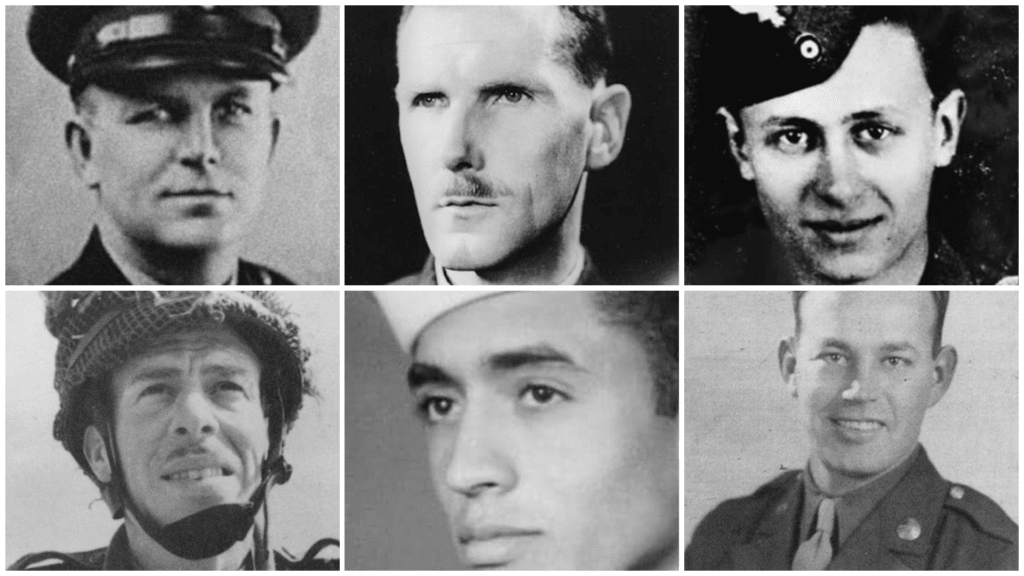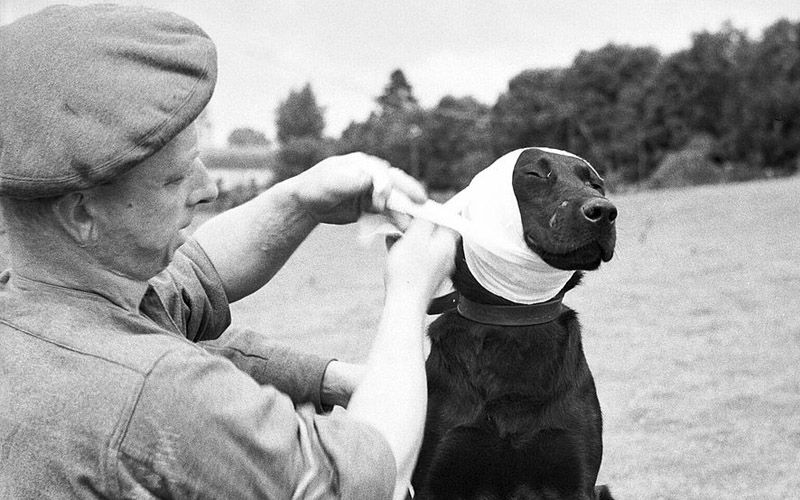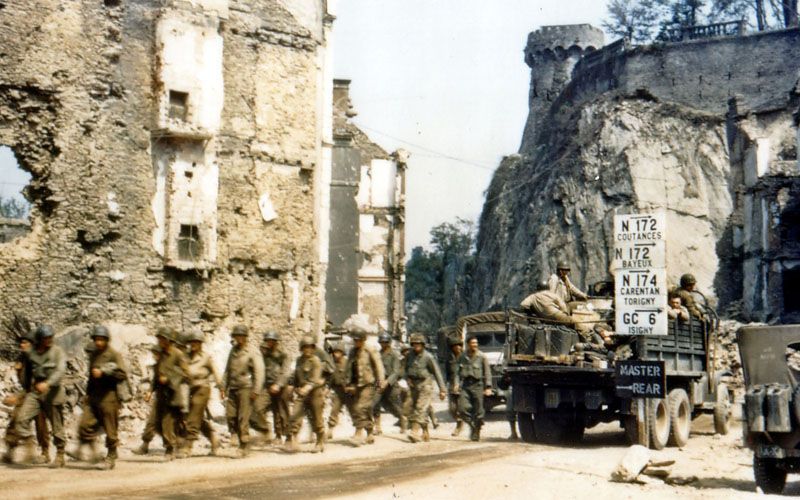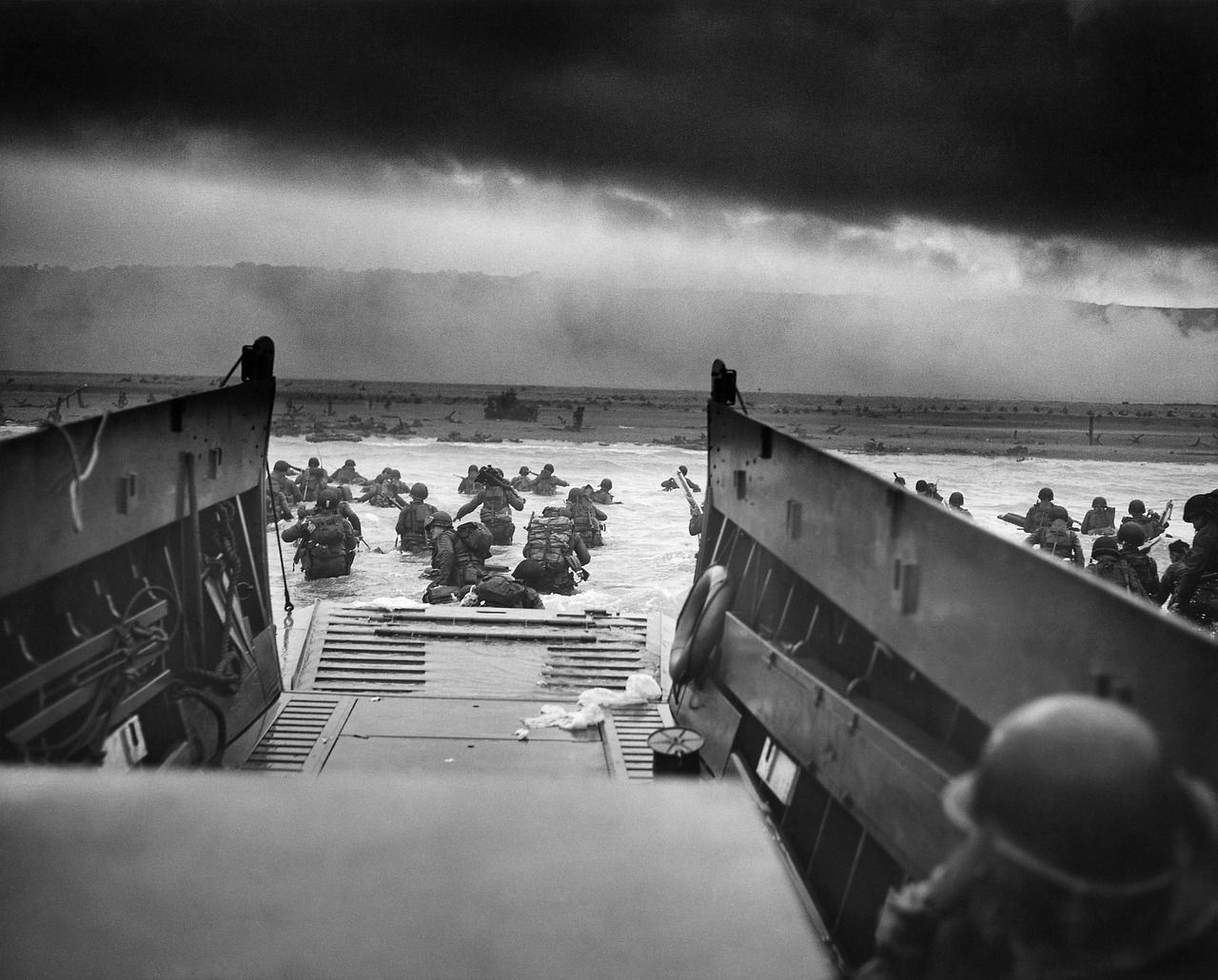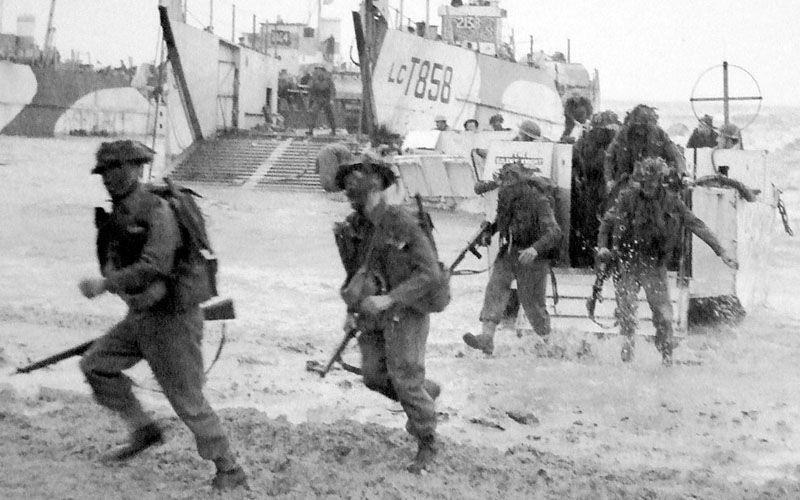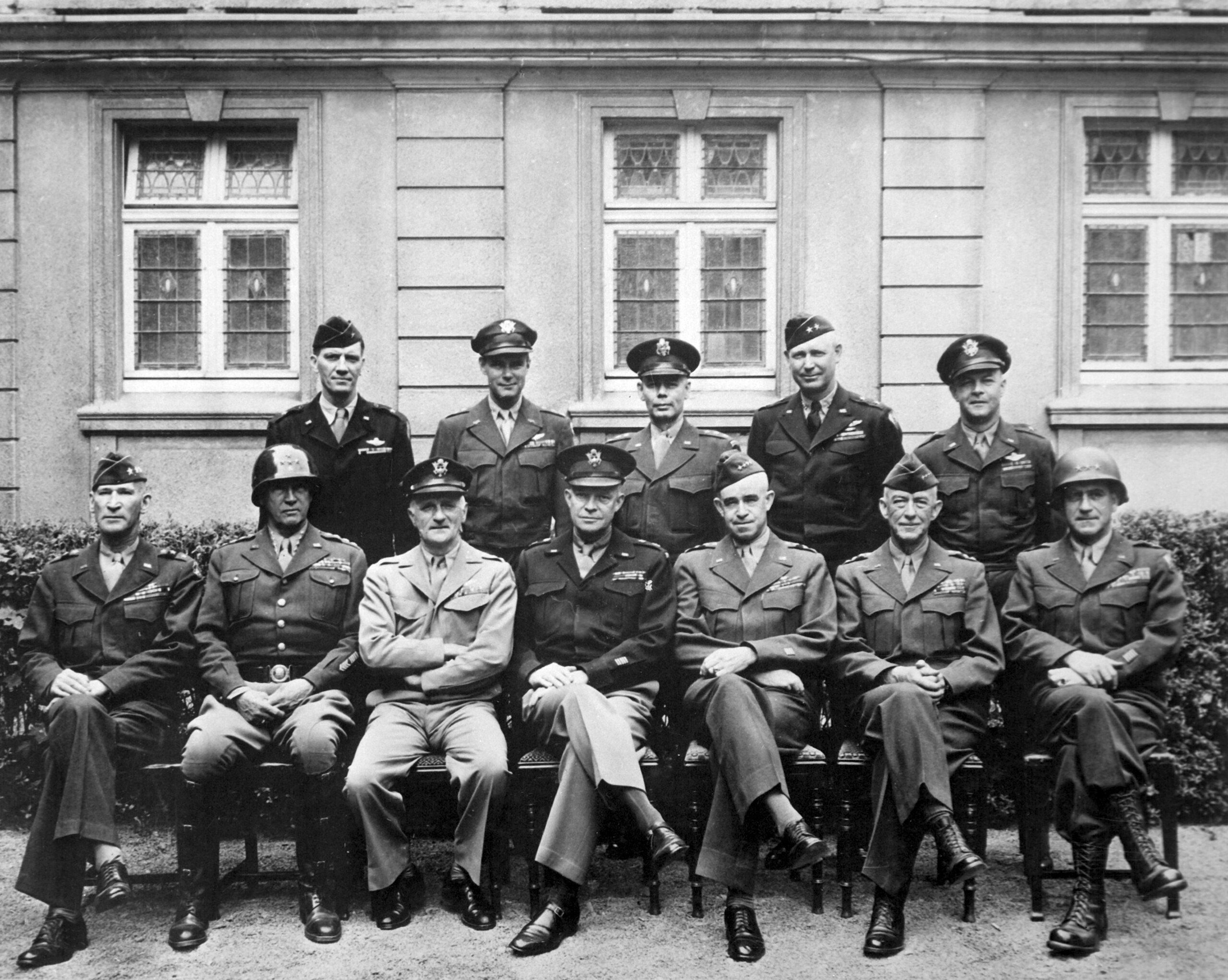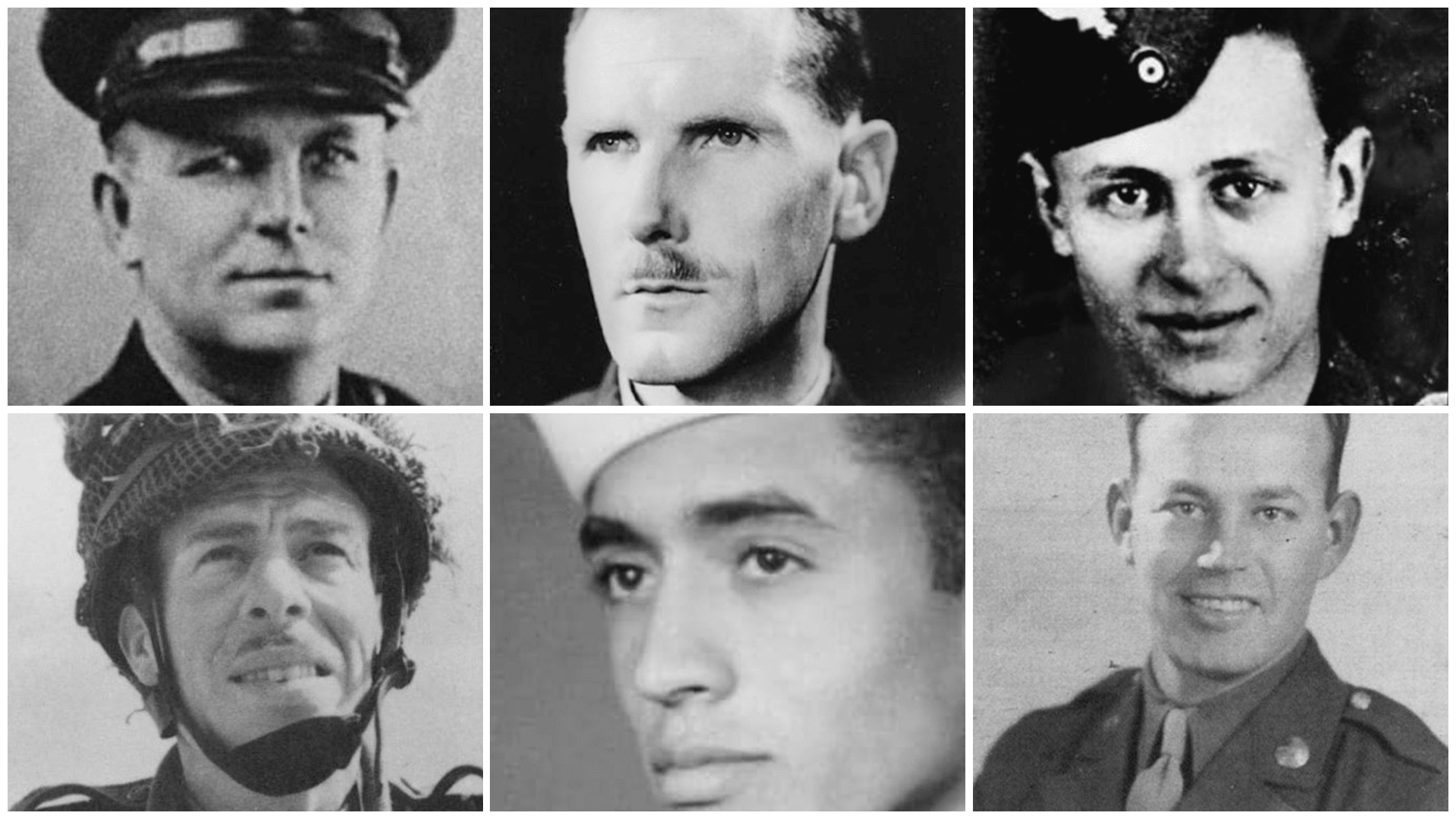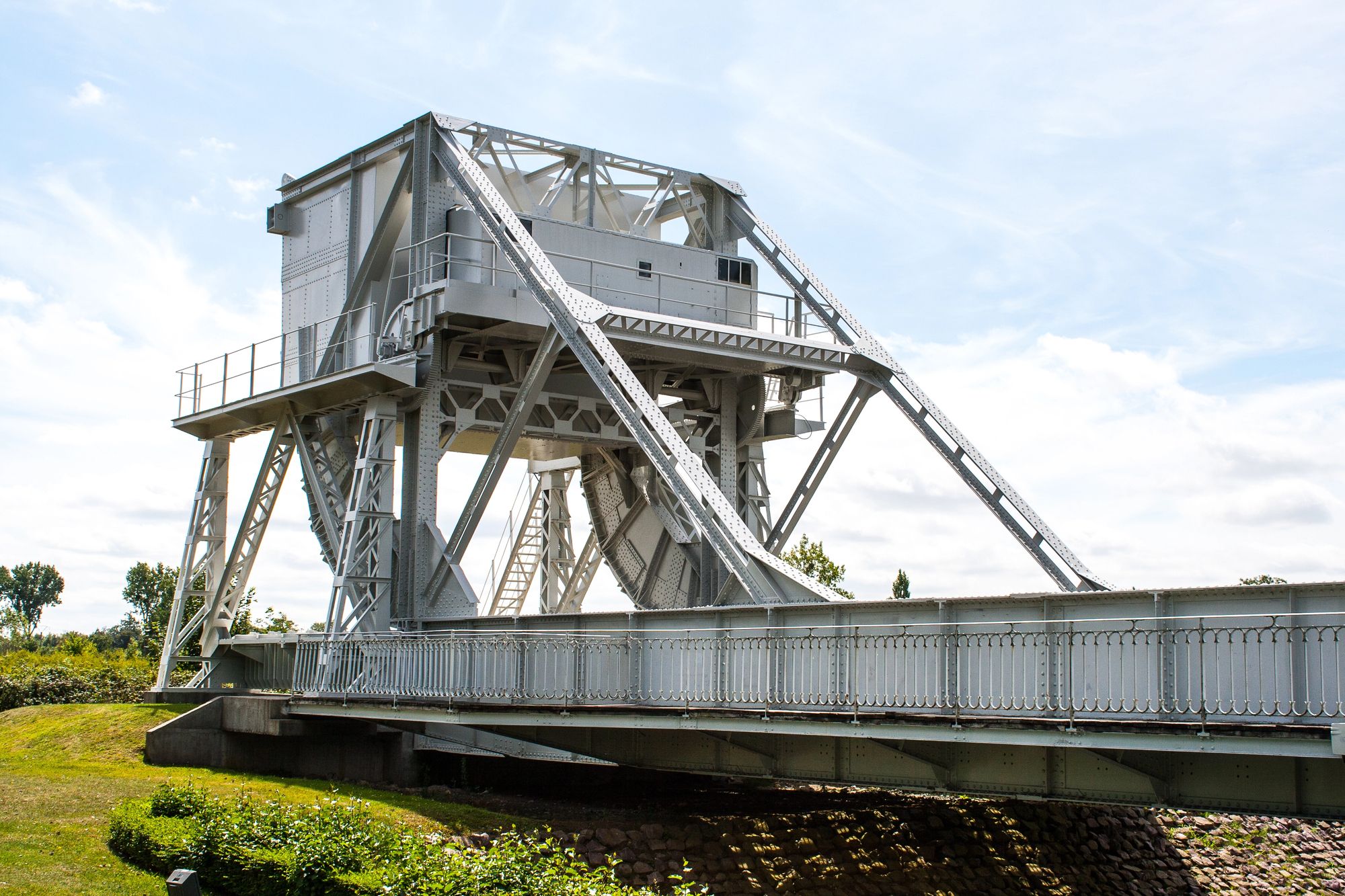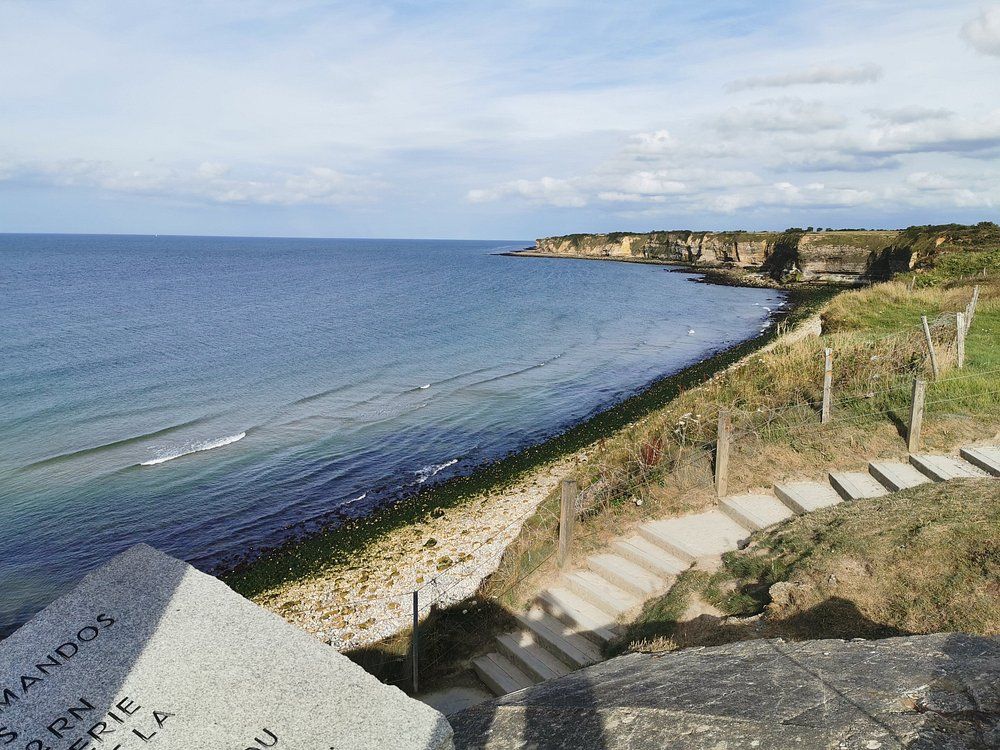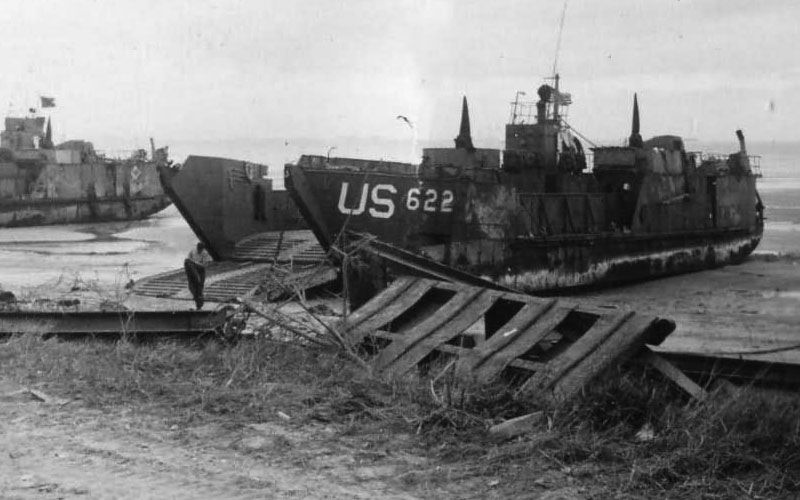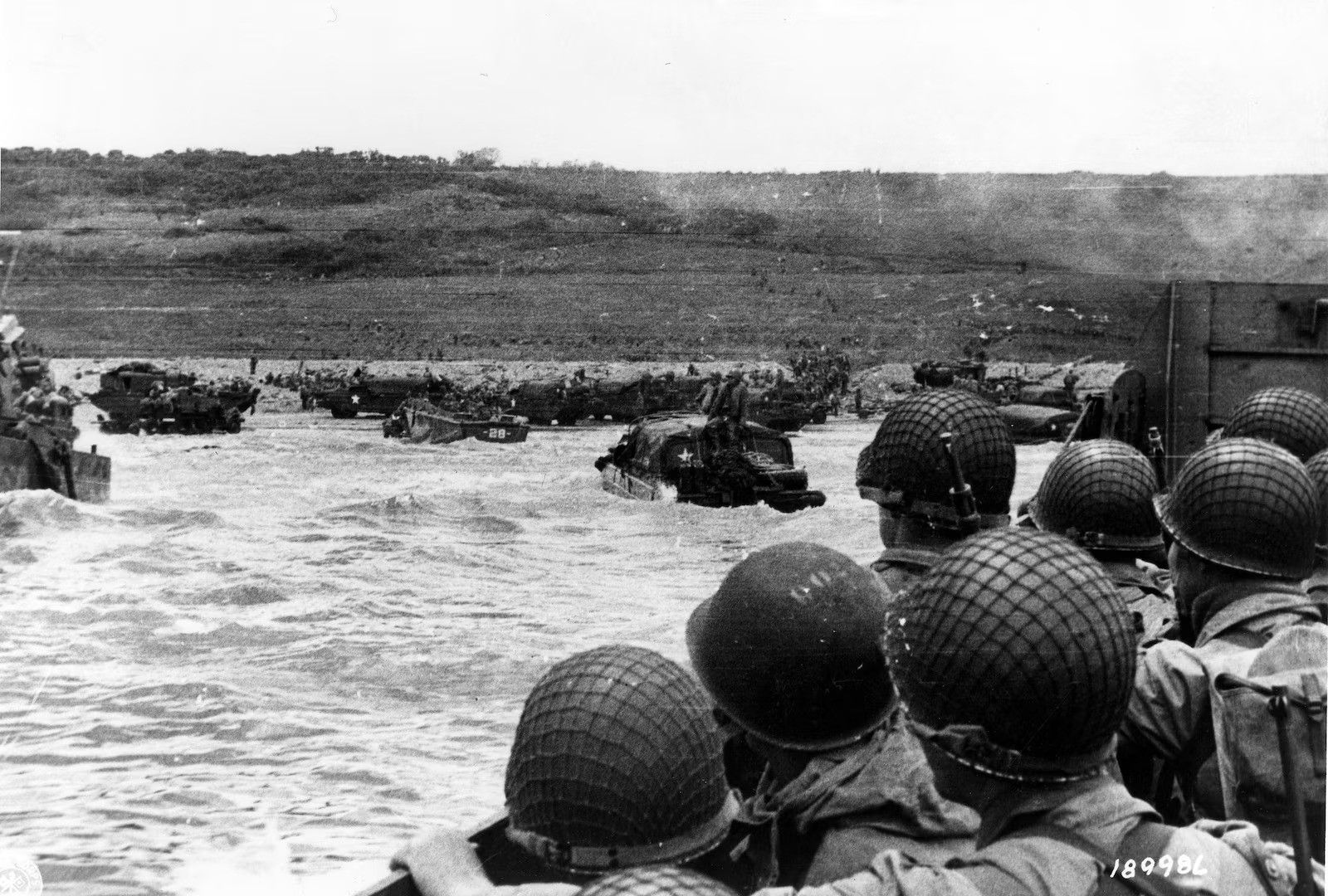Over 150,000 Allied troops were landed or dropped into Normandy on 6th June 1944. Many more would follow them. As well as the fighting forces, thousands of others performed vital functions in research and development, intelligence, logistics and others areas. An entire website could be dedicated to profiling just a fraction of those involved.
Human Stories
Here we take a brief look at just a handful of those with links to the Normandy Campaign – from both sides of the conflict. Some you will almost certainly know, but we hope a few at least may be new to you.
Bailey, Donald
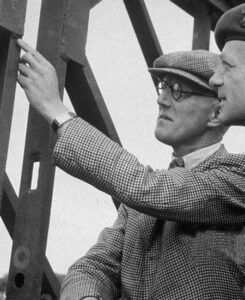
Civilian Engineer
Donald Bailey was a civil engineer from Rotherham. Born in 1901, at the time of the Second World War he was a civil servant in the War Office.
As a hobby, Bailey enjoyed constructing model bridges and in 1940 he came up with an idea for a portable bridging system which he presented to the War Office. The idea generated some interest and he was instructed to continue development in his own time. His designs were eventually approved, however, due to the emphasis on other types of war production it wasn’t until early 1944 that manufacturing of the components really started in earnest.
A “Bailey Bridge” was transported in kit form and carried by trucks. It could be erected by a team of specially trained engineers using basic tools, ropes and pulleys. A considerable number of these bridges were used in Normandy and throughout the Allied advance to provide crossing points over the many rivers of Europe whose bridges had been destroyed. Field Marshall Montgomery said of the Bailey’s invention:
“Bailey bridging made an immense contribution towards ending World War II. As far as my own operations were concerned, with the Eighth Army in Italy and with the 21 Army Group in Northwest Europe, I could never have maintained the speed and tempo of forward movement without large supplies of Bailey bridging.”
He died in 1985 aged 83 whilst living in Bournemouth. In the neighboring town of Christchurch, where many of the bridge components were built, a section of “Bailey Bridge” still stands as a tribute in Barrack Road. Sections of Bailey Bridge are still in use around the world to this day.
Berra, Yogi
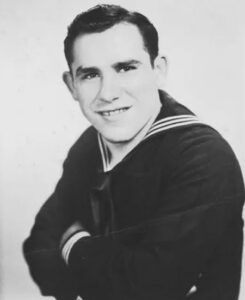
Seaman, 2nd Class, US Navy
In 1943 Lawrence Berra, better known as “Yogi”, received his draft card. The 17 year old made his way from the baseball park where he played to join the Navy, leaving behind him a $90 per month job playing for the Norfolk Tars – one of the teams in the New York Yankees farm system. One year later he would find himself off the coast of Normandy.
Berra volunteered for amphibious landing craft and on D-Day was a “rocketboat man”. Rocketboats were fast, 36-foot gunships. With a six-man crew they were armed with 24 rockets, two .30-caliber machine guns and a twin .50-caliber machine gun. On D-Day, the 24 boats would be out in front of the full landing force of the Allied invasion.
The boats broke out of the dawn mist on the English Channel, firing rockets at fortified German positions. Part of the job was to fire and part was to draw fire, so the German machine gun nests could be identified for airstrikes. “It was like the 4th of July out there,” Berra said years later. “You couldn’t stick your head up or it would get blown off.” In the days after the landing, the rocketboats were used to patrol the invasion coast, still coming under enemy fire and returning it.
After the war, Yogi Berra would become one of the most famous baseball catchers of all time, playing for the New York Yankees between 1946 and 1963. After a brief stint playing for the New York Mets, he retired from baseball but returned to manage both the Yankees and the Mets in later years. After winning ten World Series rings, Yogi Berra was finally inducted into the National Baseball Hall of Fame in 1972, and in the same year the New York Yankees retired the number “8” from their roster.
Yogi Berra died in his sleep at the age of 90 on 22nd September 2015 – 69 years to the day after his MLB debut. To honor Berra, the New York Yankees added an “8” patch to their uniforms, and the Empire State Building was lit with blue and white vertical “pinstripes”. New York City Mayor Bill de Blasio ordered all flags in the city to be lowered to half-mast for one day in tribute, and a moment of silence was held before the 23rd September games of the Yankees, Dodgers, Astros, Mets, Nationals, Tigers, and his hometown team the St. Louis Cardinals.
Börner, Johannes
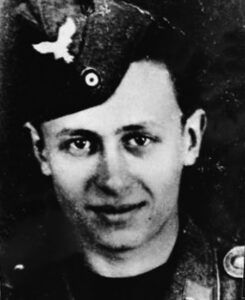
Corporal, German Air Force
Originally from Leipzig in Germany, in 1944 Corporal Johannes Börner was serving with the 3rd “Fallschirmjäger” (parachute) Division of the German Luftwaffe. On 6th June he was actually several hundred miles from the beaches of Normandy, stationed with his unit in Landerneau near Brest in Brittany. In the early hours he and his comrades were roused from their beds by an alert that the invasion had begun. The Fallschirmjäger were actually Luftwaffe troops, but by this period of the war such “Fallschirmtruppen” units were tactically subordinated to Army command.
In the evening of D-Day Johannes’ unit headed from their barracks towards Saint-Lô. Although the “3. Fallschirmjägerdivision” was supposed to be motorized, by June 1944 it still only had 40% of its authorised motor transport, even after commandeering local vehicles. Although some of the troops left on trucks for Normandy, Börner was among those who would make the journey on foot. The troops marched for over two hundred miles, moving mainly at night, and arrived near Saint-Lô on 12th June and forming up with the motorized part of the unit which had arrived on the 10th.
After bitter fighting, Johannes escaped the city on 17th July before being involved in a series of fighting retreats during the American Operation Cobra. He and his unit eventually found themselves amid the destruction and devastation of the Falaise Pocket. After three days of aerial and artillery bombardment, and unable to escape eastward through a narrow gap the Germans had dubbed “the corridor of death”, Börner was captured by Canadian troops on 21st August. Of his original company of 120 men, only nine had survived.
He joined 6,000 other Prisoners of War at an Allied camp near Bayeux, but when the war ended and he was released in September 1945 he elected to remain in Normandy. His home town of Leipzig was now under the thumb of communism as part of the German Democratic Republic (East Germany). He worked as farm laborer for a time, and eventually married a French girl in 1954. Two years later he became a French citizen.
In 1969 he and his wife, Thérèse, bought a hotel and restaurant in Ouistreham which they ran for over 30 years. In later life, Johannes became good friends with another Ouistreham resident, Léon Gautier, a French D-Day veteran who landed at Sword Beach as one of Philippe Kieffer’s commandos. Together Johannes and Léon travelled delivering messages of peace to younger generations.
Johannes Börner passed away in May 2018, leaving behind several generations of his French family.
Currie, David
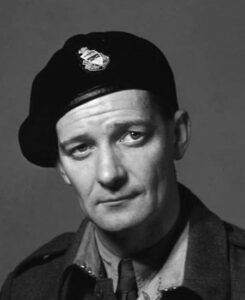
Lt Colonel, Canadian Army
David Currie joined the Canadian Army before the war, rising to the rank of Major by 1944 where he commanded a battle group of tanks from the South Alberta Regiment Artillery and Infantry of the Argyll and Sutherland Highlanders. He was awarded the Victoria Cross in Normandy for his actions during the battle to close the Falaise Gap.
Between 18th and 20th August, Currie was in command of a small force consisting of tanks, self-propelled anti-tank guns and infantry. He had been ordered to seal off one of the Germans’ primary routes of escape, and after consolidating his position inside the village of St. Lambert-sur-Dives, his unit repulsed repeated German assaults over the next 36 hours. Despite heavy casualties, Major Currie destroyed seven enemy tanks, twelve 88mm guns and 40 vehicles. Around 300 Germans were killed and another 500 wounded. Over 2,000 were taken prisoner and the remnants of two German armies were denied an escape route.
Just a month following the events in Normandy which earned him a Victoria Cross (the only VC to be awarded to a Canadian in Normandy), he took part in the Battle of the Scheldt to liberate the Netherlands.
After the War, Currie served as the Sergeant at Arms in the Canadian House of Commons between 1960 and 1978. He died in Ottawa in June 1986 at the age of 73.
Davison, George A.
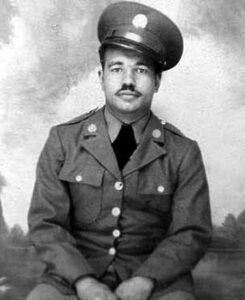
Sergeant, US Army
George Davison was one of the many black soldiers to serve in Normandy. Although the US Army was still segregated at the time and black soldiers were unable to serve in combat roles, many served in support units on the front line.
Davison was a Sergeant with the 320th Anti-Aircraft Barrage Balloon Battalion (VLA). On 6th June he was aboard LCT 608 with Army Rangers headed for Omaha Beach. The mission of the all-black 320th was to prepare and launch anti-aircraft barrage balloons to protect the landing beaches from aerial attack by the Luftwaffe. Some members of the Battalion also served as medics.
Sergeant Davison risked his life carrying messages between unit commanders under the cover of night, dodging enemy fire as he went. He died in 2002 at the age of 80.
Diekmann, Adolf
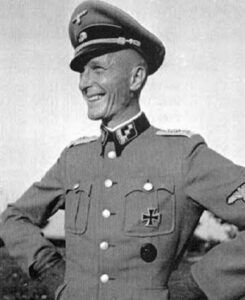
Major, German Army
Adolf Diekmann, sometimes referred to as Otto Diekmann, died in Normandy on 29th June and is buried at La Cambe Cemetery. He was killed by a shrapnel wound to the head whilst in command of the 4th SS Panzer Grenadier Regiment Der Führer. However, he is more notoriously recognized for his actions in another part of France.
Shortly after D-Day, the 2nd SS Panzer Division Das Reich was ordered to redeploy to Normandy from their location in the Vichy-controlled area of France. The advance was delayed by actions of the resistance and agents of the SOE.
On 10th June, Diekmann’s unit entered the small Limousin town of Oradour-sur-Glane. The town was sealed off and the inhabitants ordered to assemble in the square. Whilst the women and children were forced inside the church, the men were led to six barns. The Germans set the church ablaze and fired machine guns into the barns. 642 men, women and children perished at Oradour. Only six managed to escape.
Diekmann defended his actions by saying they were retribution for the deaths of 40 German soldiers killed by partisans in the nearby town of Tulle on 8th June.
Gellhorn, Martha
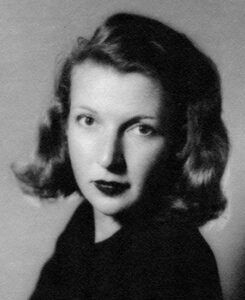
Journalist
Born in 1908 in St Louis, Missouri, Martha Gellhorn was the third wife of novelist Ernest Hemingway. As a journalist she covered the Second World War from Finland, Hong Kong, Singapore, Burma and Britain.
Gellhorn was denied credentials to travel to Normandy to report on the D-Day landings. Undeterred, however, she tricked her way onto a hospital ship by telling a guard she was interviewing some of the nurses on board. Once aboard she stowed away inside a toilet compartment, and when the ship reached Omaha Beach she blended in with other women going ashore. After witnessing the aftermath of D-Day first hand, she helped carry stretchers of wounded before writing her article.
Around the time of Operation Market Garden, Martha Gellhorn was romantically linked to commander of the US 82nd Airborne and Normandy veteran, General James Gavin.
Heralded as one of the greatest female war correspondents of all time, Martha Gellhorn went on to cover the Vietnam War, Six Day War, and even reported on the US invasion of Panama at the of 81.
Seriously ill from ovarian and liver cancer, and nearly blind, Martha Gellhorn committed suicide in February 1998 in London.
Gilchrist, Stanley
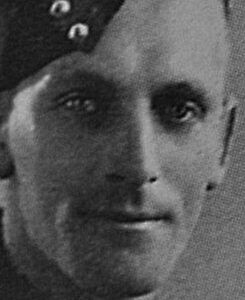
Private, British Army
Welshman Private Stanley Gilchrist of 2nd Battalion of the Royal Warwickshire Regiment landed on Sword Beach as part of the British 3rd Division. He and a comrade were injured during fighting as their unit made its way to relieve Allied soldiers at Pegasus Bridge.
Captured by the Germans, Gilchrest and the other soldier were taken by truck and left to die in the town of Herouville-Saint-Clair – now a suburb of Caen. The townspeople took care of the wounded soldiers, hiding them in the school, but their injuries were so serious that they had to enlist the assistance of a German doctor. The following day German soldiers returned and took the two Allied soldiers. It is not known what happened to Gilchrist’s comrade, but Stanley spent was taken to Rennes as prisoners of war.
Relatives back home were unaware of Stanley’s situation and feared he had been killed in action. It was only when Gilchrist was mentioned by Lord Haw-Haw in a German propaganda broadcast that they learned his was alive and safely in captivity. He was finally freed in August 1944 when American troops liberated Rennes.
Stanley returned to Normandy 40 years after the war. As he stood taking photographs of the area where he’d been left by the German truck he was approached by a French woman, who, it turned out, remembered the injured soldiers. She had given them Calvados brandy to comfort him as he lay in the street in 1944.
Gockel, Franz
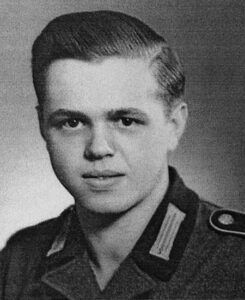
Private, German Army
Franz Gockel was born in December 1925 in Rhynern. He celebrated his 18th birthday in Normandy whilst serving with the 716th Infantry Regiment of the 726th Infantry Division.
On the morning of D-Day, Gockel was manning his captured Polish machine gun at widerstandsnest 62 (resistance post) overlooking the sands of Colleville-sur-Mer. The 35 men of Wn62 were in the strongest defensive position on Omaha Beach. In the afternoon of 6th June, Gockel was wounded in the hand and later made it to Bayeux for treatment.
In later life he had returned to the beaches of Normandy many times, and become friends with American D-Day veterans. The boots he wore on D-Day are a featured exhibit the National World War II Museum in New Orleans. He received the German “Federal Cross of Merit” for his efforts to promote international understanding.
Franz Gockel died in 2005.
Gorman, John
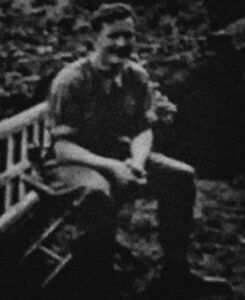
Lieutenant, British Army
John Gorman – later Sir John Gorman, CVO, CBE, MC, DL – was a 21 year old Lieutenant with 2nd Battalion Irish Guards during the Normandy Campaign. On 18th July 1944 during Operation Goodwood, whilst in command of a Sherman tank, Gorman’s troop was at Cagny not far from Caen when it came across four German tanks – including a Tiger B (also known as the “Tiger II” or “King Tiger”).
Gorman’s tank fired one shot at the King Tiger, but was thwarted by the thick, angled armor of the German machine. The Sherman’s gun jammed before a second shot could be taken and so Lieutenant Gorman instructed his driver – Lance Corporal James Baron – to ram the enemy tank. As the German tank began to traverse its 88mm main gun the Sherman collided with the Tiger B disabling both machines.
Both the German and British crews abandoned their tanks. Gorman later returned with the better armed Sherman Firefly and finished off the Tiger. For his actions he was awarded the Military Cross, whilst Lance-Corporal Baron was awarded the Military Medal. In 2007 Gorman was awarded the French Croix de Guerre for his actions during the War.
Following the war, Gorman served as District Inspector of the Royal Ulster Constabulary until 1963. He then moved into politics and eventually became Deputy Speaker of the Northern Ireland Assembly in 1998. He died in County Down aged 91 in May 2014.
Hay, Vera
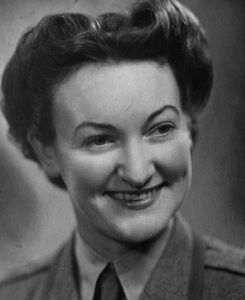
Junior Sister, British Army
Vera Hay was a Junior Sister with the Queen Alexandra’s Royal Army Nursing Corps and was one of the first women to land in Normandy.
After arriving on Gold beach, a week after D-Day, Vera Hay was taken a few miles inland to the Château de Beaussy near Bayeux where a field hospital was in operation. She helped treat up to 200 wounded each day – both Allied and German.
Vera and the other nurses worked around the clock with no traditional shift pattern. Often times, rest periods were snatched an hour at a time. Until tented accommodation was eventually arranged rest was spent in a ditch.
In 2009 she was the only woman among ten Second World War veterans to receive the Legion d’Honneur – France’s highest decoration. She is currently the secretary of her local Normandy Veterans Association, and in 2014 was featured in the book Last of the Liberators.
Heintz, André
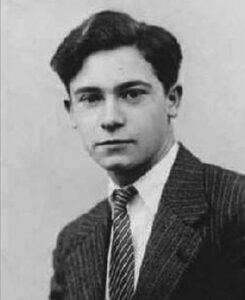
French Resistance
Between 1940 and 1944, young Frenchman André Heintz operated as a member of the French Resistance. He was recruited by a Polish-French priest and friend of the family, Father Makulec. Although he longed for action, André was tasked with intelligence gathering. Although he was twenty years old when he joined the resistance, he was quite small and when dressed as a schoolboy could easily pass for someone much younger. André would ride his bicycle around Caen and go completely unnoticed by the Germans, and then pass his intelligence.
From his mother’s cellar he would listen to broadcasts from London on a crystal radio set which he had modified himself to enable it to receive messages from the BBC with instructions for the Resistance. André also built a small camera and was very talented at creating fake identification documents. His counterfeit papers allowed downed airmen to be smuggled through German lines and enabled a number of Jews to escape from Normandy.
As the Allies prepared to launch the final push to capture Caen, the City was pounded by artillery and bombs. Heintz’s sister, a nurse working in the Bon Sauveur convent since the destruction of the local hospital, draft André to help. A head nurse demanded that the Resistance inform the Allies that the convent was now being used as a hospital. Knowing this was not possible, André and his sister used sheets soaked in blood to create a large red cross on the roof. The convent and Caen cathedral were two of the only buildings to survive the bombardment of Caen.
In 1982 he retired from his 39 year career as a teacher, but continued his interest in historical research. André Heintz was instrumental in the establishment of Le Mémorial de Caen.
Higgins, Andrew
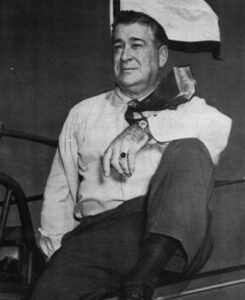
Civilian
An extremely colorful character, Higgins was born in Nebraska in 1886. Before for the First World War he served in the Nebraska Army National Guard before leaving to enter the lumber industry, and eventually formed his own lumber business in 1922. In order to support the barges and tugs needed by his lumber business he also started his own shipyard, completed a correspondence course in Naval Architecture and started to build different types of motorboats and launches.
One of his early designs was called the Wonder Boat. It was popular with rum runners during the prohibition period between the Wars due to its speed and maneuverability. Higgins sold the fastest boats to the bootleggers, then managed to sell the US Coast Guard slightly older and slightly slower boats with which to try and catch them
From the Wonder Boat, Higgins developed the Eureka Boat. It was fast and able to operate in shallow waters and its semi-tunneled propeller was protected it from floating debris. The US Marine Corps, frustrated with the Bureau of Construction & Repair’s inability to meet their requirements, showed great interest in the design although were not so keen on that fact that debarking troops had to go over the side exposing them to greater risk from enemy fire. Higgins and his engineers adapted the design and added a bow ramp – something the Japanese had been using in their war with China. This modified design became the LCVP (Landing Craft, Vehicle, Personnel – but was known to many simply at the “Higgin’s Boat”.
Higgins Industries designed and constructed significant quantities a war material, including other types of landing craft, PT boats, torpedo tubes, gun turrets and smoke generators. Over 20,000 boats were produced by the Company during the war. By the end of the War an estimated 92% of the US Navy’s fleet consisted of craft built by Higgins Industries. The LCVP was essential to D-Day and other Allied amphibious landings. General Eisenhower said:
“Andrew Higgins is the man who won the war for us. If Higgins had not designed and built those LCVPs we never could have landed over an open beach. The whole strategy of the war would have been different.”
Andrew Higgins died in New Orleans in August 1952. His sons continued the business until financial problems forced them to sell it in 1959. In the early 1960’s the factory in New Orleans became NASA’s Michoud Assembly Facility where elements of the Saturn rockets for the Apollo program were constructed.
Hobart, Percy
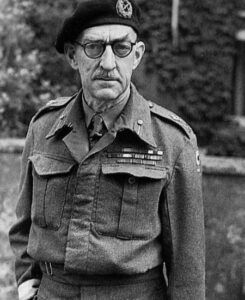
Major General, British Army
Born in Naini Tal, British India in 1885 Hobart fought on the North West Frontier in the First World War, receiving the Distinguished Service Order (DSO) and Military Cross (MC) for his actions.
In 1923, Hobart requested a transfer to the Royal Tank Corps – foreseeing that tank warfare would be a critical element of future conflicts, and eventually formed the Mobile Force (Egypt) – later to become the “Desert Rats” or 7th Armoured Division. In 1939 Major General Percy Hobart was sent into retirement by General Sir Archibald Wavell who was acting upon an unfavourable report of Hobart from another officer who had an axe to grind. He returned to Britain and an appeal against his dismissal was made to the King, but it was never put forward by the War Office. Hobart returned to his family and joined the Home Guard as a Lance Corporal.
Winston Churchill was furious about Hobart’s situation and personally intervened. In a letter to the Chief of Imperial General Staff in October 1940 Churchill wrote “I am not at all impressed by the prejudices against him in certain quarters….The catalogue of General Hobart’s qualities and defects might almost exactly be attributed to any of the great commanders of British history.”
Hobart was assigned to raise and train the 79th (Experimental) Armoured Division Royal Engineers, and was tasked with developing a series of modified equipment to address the lessons learned from the disastrous raid on Dieppe in 1942. Although some of the ideas had been previously used or were already in development, “Hobart’s Funnies” would become the largest and most elaborate collection of specialist engineering vehicles. Amongst the many designs were the “Crocodile” flamethrower, the “Crab” flail mine-clearer, and most notably the “DD” or “Duplex Drive” amphibious tank.
Although one-third of the available equipment was offered to American forces, there was very little interest. Eisenhower was keen on the use of the DD tanks but left the decision about the other types to General Omar Bradley, Commander of US First Army. Only the DD tanks saw action with the Americans on D-Day. Their reluctance was partly from that although some of the “Funnies” were based on Sherman vehicles, many others used the “Churchill” platform and they did not wish to introduce another type of vehicle to their inventory.
The 79th did not deploy as a single entity on D-Day but was attached to other units, with extremely successful results on the British and Canadian beaches. By the end of the War some 7,000 vehicles were in service with Hobart’s Division. After the War, General Bradley received some criticism for his decision not to use more of the “Funnies”, which it was felt could have saved many American lives.
In 1946, at the age of 61, Hobart retired from the British Army. During his military career he had been mentioned in dispatches nine times. After the War he was awarded the American Legion of Merit. He died in 1957 in Surrey.
Howard, John
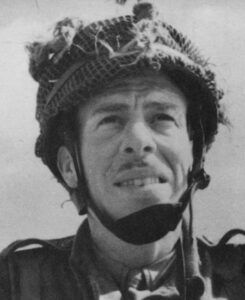
Major, British Army
John Howard served as a Private and later as an NCO with the British Army between 1932 and 1938. After leaving the military to join the Oxford police he was recalled to service after the outbreak of war in 1939. He rose through the ranks, finally receiving a commission as second lieutenant in 1940.
When the commander of 6th Airborne Division – Major General “Windy” Gale – approached Brigadier Hugh Kindersley for his suggestion on which unit to carry out a special mission on D-Day, it was John Howard’s D Company of the Oxfordshire and Buckinghamshire Light Infantry that was recommended. To test the veracity of this choice, Howard’s unit took part in a training exercise to capture three bridges from members of the Parachute Regiment. General Gale watched the exercise accompanied by Brigadiers Kindersley and Poett. All three were impressed by the performance of Howard and his men.
In April 1944 Howard was told that his unit would be charged with capturing two vital bridges intact during the forthcoming Allied assault. D Company was increased in size on the orders of General Gale, and Howard was told to form an additional two platoons of men of his own choosing from the rest of the battalion.
On the night of 5th June, Howard and his 139 of his men took off from Tarrant Rushton airfield in six Horsa gliders, each towed by a Halifax Bomber. Three gliders were assigned to capture the swing bridge over the River Orne and three to capture the nearby bascule bridge over the Caen Canal. One of the gliders mistakenly landed some 10km away near a bridge over the River Dives.
The five remaining gliders landed just after midnight and within a short period of time both bridges had been secured with the loss of two men dead and fourteen injured. Through the night the raiders were reinforced by men of the 7th Parachute Battalion and were eventually relieved later in the day by Lord Lovatt’s 1st Commando Brigade supported by tanks from Sword Beach.
Whilst on leave in November 1944, Howard was badly injured in a car accident and took no further part in the war – remaining in hospital until March 1945. He was awarded the Distinguished Service Order for his actions in Normandy, along with the French Croix de Guerre avec Palme.
Later in life he returned to the bridges near Caen many times and was involved in the creation of the Mémorial Pegasus at Benouville He died in May 1999 aged 86. The Mémorial Pegasus was opened by The Prince of Wales the following year.
Hollis, Stanley E.
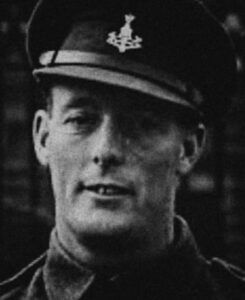
Company Sergeant Major Stanley Hollis
Serving as a dispatch rider, Hollis was evacuated as part of the British Expeditionary Force (BEF) from Dunkirk in 1940 before fighting with the 8th Army in North Africa. He was promoted to Company Sergeant Major shortly before taking part in the invasion of Sicily, where he was wounded at the Battle of Primosole Bridge.
On D-Day Stan Hollis landed at Gold Beach with the Green Howards, and he has the unique distinction of being the recipient of the only Victoria Cross awarded for actions on D-Day. The citation for his Victoria Cross reads as follows:
“In Normandy, France, on 6th June 1944, during the assault on the beaches and the Mont Fleury battery, C.S.M. Hollis’s Company Commander noticed that two of the pillboxes had been by-passed and went with CSM Hollis to see that they were clear.
When they were 20 yards from the pillbox, a machine-gun opened fire from the slit and CSM Hollis instantly rushed straight at the pillbox, firing his Sten gun. He jumped on top of the pillbox, recharged his magazine, threw a grenade in through the door and fired his Sten gun into it killing two Germans and making the remainder prisoner.
He then cleared several Germans from a neighbouring trench. By his action he undoubtedly saved his Company from being fired on heavily from the rear and enabled them to open the main beach exit.
Later the same day in the village of Crepon, the Company encountered a field gun and crew armed with Spandaus at 100 yards range. CSM Hollis was put in command of a party to cover an attack on the gun, but the movement was held up.
Seeing this, CSM Hollis pushed right forward to engage the gun with a PIAT from a house at 50 yards range. He was observed by a sniper who fired and grazed his right cheek and at the same moment the gun swung round and fired at point blank range into the house. To avoid the falling masonry CSM Hollis moved his party to an alternative position. Two of the enemy gun crew had by this time been killed and the gun was destroyed shortly afterwards.
He later found that two of his men had stayed behind in the house and immediately volunteered to get them out. In full view of the enemy who were continually firing at him, he went forward alone using a Bren gun to distract their attention from the other men. Under cover of his diversion, the two men were able to get back.
Wherever the lighting was heaviest CSM Hollis appeared and, in the course of a magnificent day’s work, he displayed the utmost gallantry and on two separate occasions his courage and initiative prevented the enemy from holding up the advance at critical stages.
It was largely through his heroism and resource that the Company’s objectives were gained and casualties were not heavier and by his own bravery he saved the lives of many of his men.”
After the war Hollis had many different careers, including the landlord of a pub he renamed the “Green Howard”. He died in February 1972. His Victoria Cross was purchased in 1997 by then Chairman of Racal and Vodafone Sir Ernest Harrison OBE. Harrison donated the medal to the Green Howards museum. Ten years later he purchased for the museum the Normandy hut which Hollis had fearlessly attacked.
In November 2014 construction is set to start on a statue of Stan Hollis in his birthplace of Middlesbrough.
Jordan, Bernard
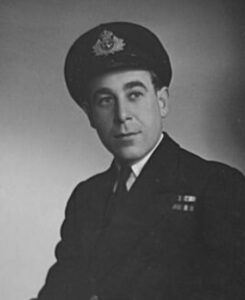
Engineer, Royal Navy
In 1941, aged just 17, Bernard Jordan lied about his age and joined the Royal Navy. Serving aboard HMS Bulldog, he had a ring-side seat at the crippling of the German submarine U-110 and the subsequent capture of a critical Enigma coding machine.
On 6th June 1944, he was an electrical engineer serving aboard the depot ship HMS Endeavour as it landed equipment in support of the Allied invasion. After the war, Bernard Jordan eventually returned to civilian life and local politics, serving as Mayor of Hove between 1995 and 1996. Jordan cited meeting Margaret Thatcher is her professional highlight.
He achieved cult status with his determined efforts to reach the D-Day 70th Anniversary celebrations in 2014.
After the staff at his care home failed to obtain a place for Bernard on an official Royal British Legion trip to Normandy, he donned his best suit – complete with medals – and caught a train from Brighton to Portsmouth. Instead of attending the British ceremonies as he had originally planned, he bought a one-way ticket on a Brittany Ferries crossing to France. During the voyage he reportedly danced with 1940’s vocal group the Candy Girls.
Staff at the Pines Care Home reported him missing and he was eventually tracked down in Normandy staying with a British family who were themselves escorting several other veterans.
Instead of a reprimand, he returned to a hero’s welcome at the Pines. The current Mayor of Brighton & Hove has requested that Bernard be awarded the Freedom of the City. Even Steve Tuckwell of Brittany Ferries has said he is entitled to free travel to the Normandy Beaches for the rest of his life.
Lane, George
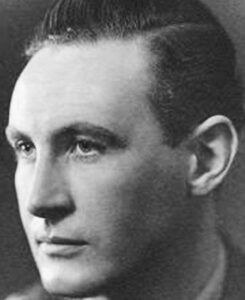
Special Operations Executive (SOE)
George Lane was born Gyuri Lanyi in Upper Hungary in January 1915. Whilst working as a journalist, this Hungarian Jew wrote an eyewitness account of a Nuremburg Rally. He moved to England in 1935 to study in London and when war broke out he volunteered for the British Army, joining the Grenadier Guards. The Home Office, however, served him with a deportation notice.
Lane was staying at Leeds Castle as a guest of American born political hostess Lady Baillie. After meeting Prime Minister Anthony Eden and Chief Whip David Margesson there he was, with their help, able to have the deportation order rescinded. However, he still had to spend a year in the Auxiliary Military Pioneer Corps which was the only military unit in which enemy aliens could serve early in the war.
After serving his time in the Pioneer Corps, Lane joined SOE (Special Operations Executive) where he learned unarmed combat, weapons and explosives, parachuting and small boat handling. After taking part in operations to Belgium and the Netherlands, he transferred to Lord Lovatt’s No.4 Commando.
Lord Mountbatten, head of Combined Operations, decreed that better use should be made of foreign-born troops in the British Army due to their language skills and hatred of Hitler. Shortly thereafter, “X-Troop” was formed as part of No.10 (Inter-Allied) Commando and George Lane helped to select the 80 original members.
In May 1944, Lane took part in the “Tarbrush Raids” to examine mines on the French coastline near Ault, not far from Dieppe. The raids were instigated because the camera on an RAF fighter strafing part of the German Atlantic Wall defenses had seemingly captured underwater explosions after the rockets it had fired fell short of their target. There was concern that the Germans had developed a new type of mine that could prove disastrous for the forthcoming invasion.
Although it was found that the Germans had simply attached Teller mines that had no waterproofing to stakes below the high-water mark, Lane was ordered to return with a sapper to photograph other parts of the beach defenses. When the raiding party was surprised by the Germans only some of them were able to escape. Lane and Sapper Officer Roy Wooldridge were captured.
Despite Hitler’s Kommandobefehl (Commando Order) which stated that Allied commandos encountered by German forces in Africa and Europe should be killed immediately without trial, Lane and Wooldridge were taken into German Army custody rather than being handed to the Gestapo. After several days the men were eventually tied and blindfolded and driven to a château at La Roche Guyon. Lane was invited into a room where he was greeted by none other than Field Marshall Erwin Rommel. Rommel questioned Lane through an interpreter as they were served sandwiches and coffee.
Although he did not give the Germans any information, Lane firmly believed that Rommel had spared his life. Later that day Lane and Wooldridge were taken to Fresnes prison near Paris, before being sent to the Officer’s prison at Spangenberg. Later in the War, as the Allied advance neared Spangenberg, the Germans evacuated the POWs. Lane was able to escape and with the help of a German Army deserter was able to make it to link up with friendly forces.
George Lane was awarded the Military Cross for “Tenacity of purpose in obtaining vital information”. His conversation with Rommel is recorded in official German war records.
After the War, Lane led a colorful and varied existence. In 1984 he returned to La Roche Guyon for the first time since the War for a Sunday Telegraph article, and ten years after that returned again for the BBC. He died in 2010.
McCann, Joseph “Eddie”
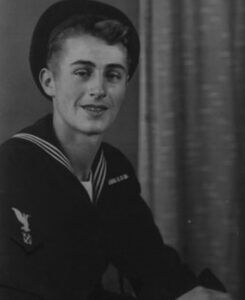
Coxswain, US Navy
Joseph “Eddie” McCann was a tall boy for his age, and so at just 13 years old he was able to convince a stranger in Oakland, California to sign papers which would allow him to join the US Navy. By the age of fifteen he was a decorated veteran after serving in North Africa and Sicily.
In April 1944 he was a coxswain of a landing craft taking part in Exercise Tiger off the Devon Coast. Following the E-Boat attack on the troop transports in the convoy near Slapton Sands, McCann volunteered to take his landing craft to search for survivors among the hundreds of bodies. His boat was able to rescue 45 survivors, but 11 of these later died. In total 749 men lost their lives in the surprise attack.
On D-Day, McCann again saw action as he delivered troops of the 1st Infantry Division (Big Red One) to shore in the first wave at Easy Red sector of Omaha Beach. He would never forget the carnage he witnessed. Later in the day he would evacuate wounded American soldiers to the hospital ships and transport captured German soldiers to LST515.
A recipient of the Bronze Star, McCann was allowed to continue to serve even after the Navy discovered his real age when he was 16. After his naval career he became a policeman and later a juvenile probation officer for the Department of Corrections.
Eddie McCann died in March 2009 in Snohomish County, Washington.
Otway, Terence
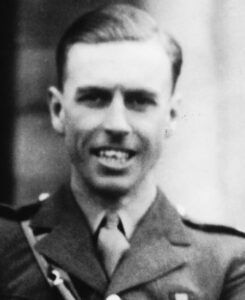
Lt Colonel, British Army
Terence Otway was born in Egypt in 1914, and shortly thereafter returned to the UK with his parents. In 1933 he entered the Royal Military College at Sandhurst. In 1934 he joined the 2nd Battalion Royal Ulster Rifles based at Gravesend in Kent.
In 1940 Otway had achieved the rank of Major and went to staff college in 1941. After a number of administrative postings, he returned in 1943 to the Royal Ulster Rifles, then part of the 6th Airborne Division. In August on that year he transferred to the Parachute Regiment to become 2IC 9th Battalion. In March 1944, following promotion to Lieutenant Colonel, he took over as commanding officer.
In the build up to D-Day, Otway was tasked with the mission to seize and neutralize the coastal artillery battery at Merville. The guns at Merville had a range of around seven miles and would be able to reach the area of Sword Beach. Otway was told that the lives of potentially thousands of British troops were at risk if the battery was not put out of action. This mission would be an element within the larger Operation Tonga.
Otway was a hard task master and the men were drilled mercilessly on mock ups of the battery. Security was critical to the success of the mission. Otway himself later said “We built a replica of the whole route from the rendezvous point in France to the battery. And that included every hedge, every ditch, every fence, they were put in place in Berkshire. It was vital that we complete secrecy, we couldn’t afford a leak. I got on to the RAF and asked them to lend me a dozen or so of their most attractive WAAFS, and I briefed the WAAFS personally and I said ‘I want you to go into Newbury, and you can do anything you like, don’t come back and tell me what you’ve done, but I want you to see if you can get any hint of what we’re going to do’. At the end of however many days it was, I can’t remember, they came back and not one single man had broken security. It was that vital. Lives, all our lives depended on it.”
The actual parachute deployment for the Merville assault was a disaster. After running into heavy anti-aircraft fire and taking evasive maneuvers the drops were scattered over an area of 50 square miles. From Otway’s original force of 750 men, only 150 could be mustered for the attack on the battery, and much of their vital equipment could not be located.
Fully cognizant of the importance of his objective, Otway pressed on with the assault despite the ever-decreasing odds. Three gliders were supposed to land in the middle of the battery. One never left England after problems with its tow cable, and the other two experienced anti-aircraft fire as they made their final run in. One landed two miles away and the other on the edge of the minefield that protected the battery. As soon as the first glider appeared Otway began the assault. Despite the drastically reduced strength of his force, the battery was captured although he lost around 50% of his attacking force to stiff German resistance.
Two days after the assault whilst conducting a routine inspection, a stray shell landed close to Otway and he was diagnosed with severe concussion. He was returned to the UK and spent time in hospital in Cardiff. Declared unfit to return to operation duties he spent the remainder of the war as a staff officer in the War Office.
In October 1944 he was awarded the Distinguished Service Order for outstanding leadership in his actions at Merville and Le Plein. The official citation stated that his “utter disregard for personal danger had been an inspiration to all his men”.
After the war he moved to India and took command of the 1st Kings Regiment (Wingate’s Burma Force) at Rawalpindi and was under instruction to turn them into the 15th (King’s) Parachute Battalion, 2nd Indian Airborne Division. Later in life he started and import/export business that specialized in toys and gifts, and even had a shop in Knightsbridge. In retirement he played an active role in supporting former soldiers and their widows. He died in 2006.
Owen, Veronica
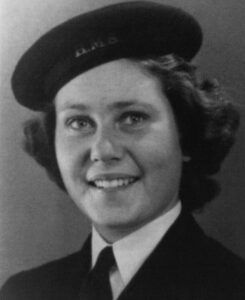
Women’s Royal Naval Service
At the start of the war, Veronica was still at school in Dorset and was among a group of girls evacuated to Canada. Determined to serve her country she returned to England in July 1942, aged 17 and a half. Because she was underage she needed her parent’s permission to join the Wrens.
In December 1942, after being trained in coding and signals, she was send to Fort Southwick – Admiral Bertram Ramsey’s headquarters in tunnels north of Portsmouth.
She was just nineteen years old in June 1944 and every third night she would spend her thirteen-and-a-half hour night shift decoding messages from ships.
She served at Fort Southwick for almost three years and became known affectionately as “Nagger number one”. She enjoyed taking a leadership role and helping her colleagues when they became baffled by codes. She was recommended for a commission on two occasions, but preferred to stay a rating – something her father referred to as her “lower deck complex”.
Veronica never married, and after writing a book of prayers she served as headmistress at Malvern Girls College in Worcestershire for 20 years. She died in 1999.
Pirrie, Richard “Digger”
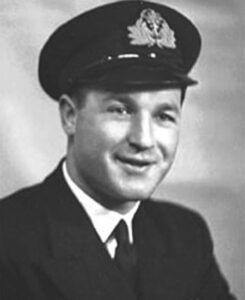
Sub-Lieutenant, Royal Australian Navy
Born in 1920, “Digger” Pirrie was an Australian Rules Football player before the war, playing for Hawthorne in the Victorian Football League.
A member of the Royal Australian Navy, Pirrie was serving aboard HMS Invicta on June 6th 1944 – which happened to be his 24th birthday. He spent the day piloting a spotter boat in close to Juno beaches. As he held the boat steady against German gunfire, another officer radioed the German positions back to Allied gunners who returned fire.
He volunteered for the task, considered by some to be a suicide mission, and despite success in targeting Allied gunfire on the coastal defenses his luck would not see out the day. His boat was hit by a shell and also struck a submerged mine, making Pirrie the first of two Australians to die in the D-Day landings.
Before the landings, Pirrie had started a letter to his family. The letter began “My dearest mother, Dad, and the boys. Well, dears, the pressure is on now and as soon as the weather improves we sail for the greatest event in the history of the world. By the time you receive this you will surely have heard some of the bare details.” He would never finish writing it.
Rayner, Raymond
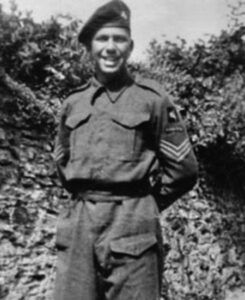
Lance Sergeant, British Army
Ray Rayner, known to his friends as “Titch”, was born in Aylesbury and in 1935, aged just 16, he joined the Territorial Army. In 1940 he was sent to France as part of the BEF, and later evacuated from Dunkirk.
Upon his return to England Rayner transferred to D Company of the Oxfordshire & Buckinghamshire Light Infantry, under the command of Major John Howard.
During Operation Deadstick to capture the Orne River and Caen Canal bridges, Rayner was aboard glider number four which was the only glider not to land on target. He later said: “We landed next to a bridge. It wasn’t the right one but as we were there we captured it.”
The following day Rayner and his platoon re-joined the other men of D Company and were subsequently involved in heavy fighting on the southern flank of the area held by the 6th Airborne Division. After the brief capture of his Lieutenant by two enemy soldiers, Rayner and Captain Brian Pridey were involved in an exchange of fire with the Germans. He managed to shoot one of the Germans, but the enemy soldier’s finger was still on the trigger and bullets were sprayed in Rayner’s direction, hitting him the right arm. “Titch” was forever after known as the soldier shot by a dead German.
After the war, Rayner returned to Aylesbury and set up a successful painting and decorating business employing over 30 men. He retired when he was 70 years old, and then spent time lecturing school groups at Bletchley Park and attending reunions in Normandy.
Ray Rayner died in April 2015. Whilst in his bed at Stoke Mandeville hospital he removed his oxygen mask and told his daughter ‘I just dreamt I was marching across Pegasus Bridge’. He passed away shortly afterwards.
Richardson, Elizabeth
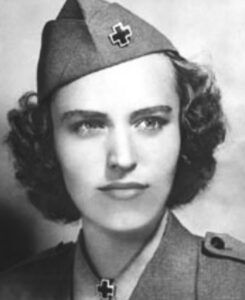
Volunteer, American Red Cross
Elizabeth A. Richardson of Mishakawa, Indiana was an artists and athlete in college. In 1944 she, along with two female college friends joined the American Red Cross. In order to qualify for posting overseas volunteers had to be single, a college graduate and at least 25 years old. They were also required to submit letters of reference and pass a personal interview and a phsyical examination. The process was so rigorous that only one in six of the applicants was selected to become a “donut dolly” working for the Red Cross Clubmobile Service.
For the the Normandy Landings, around 100 GMC trucks were converted into Clubmobiles fitted with small kitchens, each of which was driven and staffed by three American women. After the invasion, ten groups of Red Cross Clubmobile girls with eight Clubmobiles per group were sent into France. Their task was to provide servicemen with food and drink and lifting morale by providing a connection with home.
Elizabeth Richardson crossed the Atlantic on board the Queen Elizabeth in July 1944 and served in a Clubmobile in England before transferring to Normandy where she initially spent time with the 82nd Airborne. Her letters home to her family told of how she was glad she volunteered and talked affectionately of the soldiers she met.
In July 1945, whilst en route from Le Havre to Paris aboard a small two-seat aircraft, she died near Rouen. Both her and the pilot – Sgt. William R. Miller of the Ninth Air Force- were killed when their plane crashed in fog. She was 27 years old.
She is buried in Plot A, Row 21, Grave 5 in the Normandy American Cemetery at Colleville. She is one of the four women buried there. In 1982, First Lady Nancy Reagan spent three hours visiting the Cemetery behind Omaha Beach, laying flowers at Elizabeth Richardson’s grave.
Roberts, John Noble
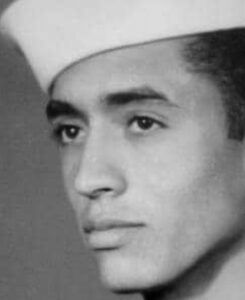
Coastguardsmen, US Coastguard
John Roberts was born in Louisiana in 1924, the first of fifteen siblings. He was drafted into the coastguard in June 1943. As an African American, the roles in which he could serve were limited, and he received training in Florida as a steward.
In January 1944 he travelled to Britain where he was assigned to USS LCI(L)91. Roberts, however, did not see eye to eye with the cook aboard the ship and requested a transfer. Two months later he was transferred to LCI(L)93.
On 6th June, the nineteen year old Roberts was working aboard an amphibious ship transferring troops across the English channel to the coast of France. The first journey was completed successfully, but on the second voyage the craft became stranded on Omaha Beach when it ran aground on a sand bank.
One of Roberts’ duties aboard the ship was to serve as runner for the Captain. Whilst taking a message to the engine room a German shell hit the ship. Roberts was badly wounded and lost his right leg as a result. A small landing craft evacuated Roberts to the USS Doyle (DD-494) for urgent medical attention.
After evacuation to England, Roberts spent the next six weeks at the 83rd General Hospital in North Wales, where he received his Purple Heart. However, due to an administrative error, it was believed Roberts was in the US Navy rather than Coastguard. His record, therefore, did not reflect his decoration until he was discharged from the Coastguard in 1945.
After the war he moved to Los Angeles and devoted his life to developing prosthetic limbs and orthotic devices.
Romer, Helmut
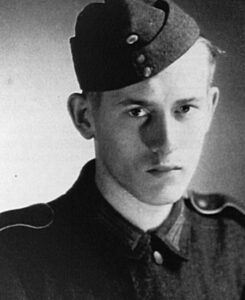
Private, German Army
The 18-year-old German Private from Berlin named Helmut Romer was potentially the very first enemy soldier to witness the start of the Normandy invasion. He was a sentry on duty at the bridge over the Caen Canal that is now immortalised as “Pegasus Bridge”.
He was nearing the end of his two-hour watch when at around 00:16hrs on 6th June, out of the silence, he heard a swishing noise followed by a bang. Romer assumed that a piece of an Allied aircraft has fallen to the ground somewhere nearby.
After a few minutes, the darkened faces of men from D Company the Ox & Bucks Light Infantry suddenly began to appear on the bridge he was guarding the several comrades.
A terrified Romer screamed the alarm and fired a flare into the air from his Very pistol. Romer, his friend named Saur and a Polish comrade ran for their lives and threw themselves into a bush to hide. They remained hidden there for 36 hours, drinking water from the canal. During their time in hiding time they witnessed the British the sinking of a boat that tried to pass along the canal and the destruction of a German tank by a PIAT fired by Sgt Thornton.
On the afternoon of 7th June, the Germans emerged from the bushes hoping the British would take them prisoner rather than shoot them. They were taken to the beach and transferred back to England with other POWs. Romer eventually ended up in Canada where he spent two years with 15,000 other prisoners.
In the 1960’s, Romer and John Howard who led the Pegasus Bridge assault became friends, meeting in Normandy every year until Howard’s death in 1999. They would have a drink in the Café Gondrée and make a toast to each other at 16 minutes past midnight on 6th June.
Rudder, James
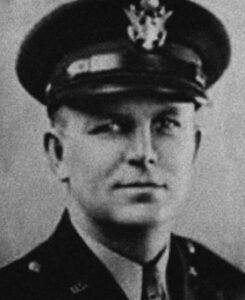
Lt. Colonel, US Army
Born in 1910 in Eden, Texas, James Earl Rudder was a football coach and teacher at Tarleton Agricultural College before the war. After graduating from Texas A&M;, Rudder was commissioned as a second lieutenant in the US Army Reserve. When war broke out he was called into active duty in 1941.
By the spring of 1943, Rudder has reached the rank of Major and was tasked with developing a training programme which emphasised teamwork and problem solving. His commanding officers were impressed with the results, and decided to put Rudder in command of the 2nd Ranger Battalion which was at the time in some disarray and desperately in need of a leader.
With almost one thousand men under his command, Rudder and the 2nd Rangers travelled to the UK aboard the RMS Queen Elizabeth in November 1943 after training in amphibious raids at Fort Pierce and advanced tactics at Fort Dix. Shortly before the voyage Rudder was promoted to Lieutenant Colonel.
In 1944, Rudder learned that his Rangers were to be tasked with the capture or destruction of the German gun battery located a Pointe du Hoc, a promontory with a 100ft cliff. The Rangers trained for the mission with British commandos, and in order to scale the cliffs used rope ladders and grapple hooks attached to rocket launchers. They even developed several DUKW amphibious vehicles with extendable ladders borrowed from the London Fire Brigade.
Before the assault, the battery was pounded by the air with more than 10,000 tons of high explosive – the equivalent explosive power of the atomic bomb dropped on Hiroshima. Rudder was in the first of the assault boats to hit the narrow strip of beach beneath the objective. Despite the intense aerial bombardment, the Germans put up stiff resistance, and although the Rangers finally fought their way to the top of the cliff and overwhelmed the defenders, they found the guns had already been removed from their casemates by the Germans.
Seven months after the battle, Rudder was assigned to the 109th Infantry Regiment which saw action in the Ardennes Offensive, more commonly known as the Battle of the Bulge. The Regiment protected 10 miles of the Allied 73 mile front line. The 5,000 men under Rudder’s command were outnumbered 10 to 1 by German troops, however, despite the odds his men held the line.
Amongst his many decorations, Rudder received the Purple Heart with Oak Leaf Cluster, Bronze Star with Oak Leaf Cluster, Silver Star, Legion of Merit, Distinguished Service Cross, the French Legion d’honnéur and Croix de Guerre avec Palme and the Belgian Order of Leopold.
By the end of the war he was a full Colonel, and was promoted to Major General of the Army Reserve in 1957. After leaving the Army he served as mayor in his home town of Brady and was later President of Texas A&M; University which he held until his death in 1970.
Since his death, each year in Normandy a ceremony is held in his honor.
Severloh, Heinrich
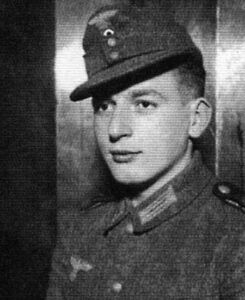
German Army
Heinrich Severloh was born in the Weimar Republic in 1923. In July 1942, at the age of 19, he was conscripted into the 19th Light Artillery Replacement Division in Hannover. In August 1942 he was transferred to France where he served with the 3rd Battery 321st Artillery Regiment where he was trained as a dispatch rider.
In December the same year, Severloh was transferred to the Eastern Front. After making some dissenting remarks, he was punished so severely that he was left with permanent health problems and required a six month convalescence in hospital.
In 1943, his was undertaking NCO training in Brunswick, when it was suddenly cut short. He instead received orders to return to his unit, now designated 352nd Infantry Division, station in Normandy.
On the morning of D-Day, Severloh was serving as orderly to Lieutenant Bernhard Frerking at Widerstandsnest 62 (“resistance nest 62”) overlooking Omaha Beach. Whilst the officer directed artillery fire onto the beach from the nearby Houtteville battery, Severloh manned an MG42 machine gun, raking withering fire across the beach.
For nine hours Severloh fired at the waves of American GI’s landing on the beaches. He later estimated that he had killed around 2,000 men.
The Americans were able to capture WN62 but Severloh managed to escape with a comrade, although wounded lightly in the face. He was later taken prisoner by American troops and sent to Boston as Prisoner of War. After his release in 1947 he travelled to England for a while, before returning to Germany.
Later in life he befriended an American D-Day veteran, David Silver, and they remained close friends until his death in 2006.
Slanger, Frances
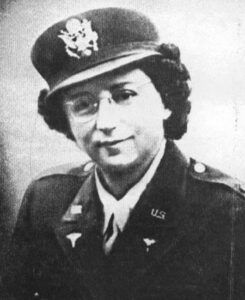
Lt, US Army
Born in Łódź, Poland, Frances Slanger emigrated to the United States with her parents when she was seven years old. She worked at Boston City Hospital as a nurse before joining the Army Nurse Corps in 1943.
After arguing for the right to be sent overseas, Lieutenant Slanger was one of four nurses to wade ashore in Normandy on D-Day as part of Second Platoon, 45th Field Hospital.
Slanger was known to be both inventive and compassionate, and she fashioned water bottles from IV bottles and rubber tubing for wounded men who found it difficult to drink water.
On October 20th 1944, whilst serving in Belgium, Slanger wrote a letter to Stars & Stripes magazine about her experiences as an Army nurse and the admiration she felt for the courage of the servicemen she treated. Shortly after writing the letter she was shot and killed by a German sniper.
In June 1945, a cruise ship, refurbished as a hospital ship to return wounded American soldiers from Europe, was commissioned as the Frances Y. Slanger.
Speidel, Hans
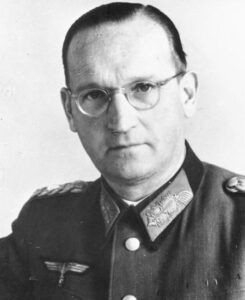
General
Born in October 1897 in Metzingen, Hans Speidel fought in both World Wars. In April 1944 he was appointed Chief of Staff to Field Marshall Erwin Rommel.
As Rommel was away in Germany visiting his wife for her birthday, Speidel was the one at Rommel’s headquarters of La Roche Guyon who was awoken in the early hours on 6th June and informed of the initial reports of Allied airborne activity. However, the incoming reports were sketchy at best and sometimes contradictory, so Speidel took the decision to wait and see what further developments took place.
At 06:20hrs he telephone Rommel at his home in Herrlingen and reported that “some sort of an attack” had been made, although he was not sure if it was the invasion or more a Dieppe-style raid. Rommel instructed him, in no uncertain terms, to find out. Speidel again contacted Rommel shortly after 10:00hrs once he’d been informed of the massive landing on the beaches.
Speidel was linked to the conspirators of the July 20th bomb plot to assassinate Hitler. Although arrested by the Gestapo they could not prove his involvement and he was found by a military court of honor not guilty, but not free of suspicion. He was imprisoned in Berlin and released by American troops at the end of the war.
After the war he served as a history professor before later being appointed commander of NATO ground forces in Central Europe in 1957, a position he held until his retirement in 1963. He died in 1984 and was buried with full military honors.
Stagg, James
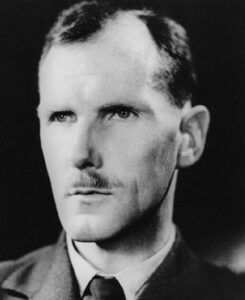
Group Captain, RAF Volunteer Reserve
James Stagg was born in June 1900 in Dalkeith, Scotland. During the Second World War he served as a Royal Air Force Meteorologist. In 1943 he was commissioned a Group Captain in the Royal Air Force Volunteer Reserve and appointed Chief Meteorological Officer for Operation Overlord.
His forecasting team consisted of members of the Royal Navy, Met Office and USAAF, and it was their responsibility to predict the weather conditions that would be experienced during the Allied invasion, scheduled to take place between the 5th and 7th June.
At the beginning of June, it was Stagg’s duty to inform the senior Allied commanders that the weather conditions were looking extremely bleak. Based on Stagg’s analysis, Eisenhower took the decision early in the morning of 4th June to postpone the landings for 24 hours from the 5th to 6th June. Later that evening, Stagg was able to report that a possible break in the weather looked possible and weather conditions could be sufficient for the landings to take place.
Eisenhower took a gamble on Stagg’s forecast and issued the order that the landings would proceed for 6th June. As it turned out the landings were not significantly hampered by the weather conditions, but the German’s own unfavorable forecasts made them believe a landing was unlikely to take place until conditions improved.
In 1945, for his services during the planning of the Overlord, Stagg was appointed an Officer of the US Legion of Merit. He also received an OBE, and was later knighted and made a CB.
Stagg later worked at the Met Office until 1960. He died in June 1975.
Steele, John
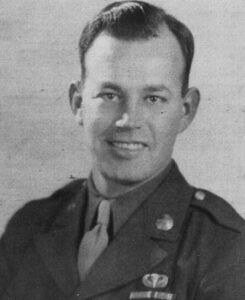
Private, US Army
John Marvin Steele was born in Metropolis, Illinois in 1912. In 1943 he arrived in North Africa as a member of F Company, 505th Parachute Infantry Regiment of the 82nd Airborne Division. He was the oldest man in F Company and was also the Company barber.
After jumping on Sicily in July, Steele broke his leg and was sent to a hospital in Tunisia. After fighting around Salerno and Naples later that year, his unit was shipped back to Britain in November to prepare for D-Day.
As part of Operation Overlord, the 82nd Airborne was tasked with parachuting into the area near of Ste-Mère-Église, however, several planeloads of paratroopers were dropped in error directly over the village. Despite the fact the time was around 01:00hrs, the church square was filled with villagers and German soldiers. The latter watching as the former hurried to extinguish the fire caused by a stray incendiary which had engulfed a building near
As paratroopers from 1st and 2nd battalions dropped helplessly into the square they were easy targets for the German soldiers. Private Steele watched in horror and his friends below him were gunned down, and then in a strange twist of fate, Steele’s parachute became tangled with the spire of the church and his descent was arrested. He was the only survivor from his “stick” (a squad of paratroopers usually consisting of between 17-19 men).
Steele had dropped his knife trying to cut himself free, and was already injured in the foot by shrapnel. He hung from the spire of church for around two hours pretending to be dead. As he did so, the bells rang incessantly and when he was finally cut down but two German soldiers his hearing was severely, but temporarily impaired. After several days in captivity he escaped and managed to rejoin American forces. Steele later participated in Operation Market Garden and fought in the Battle of the Bulge. For his actions in the war he was awarded the Bronze Star and received the Purple Heart for his injuries.
After the war Steele returned to America and led a quiet life until his role in D-Day was brought to light in the 1962 film The Longest Day, in which his character was played by actor Red Buttons. He returned to Normandy on a number of occasions and was made an honorary citizen of Saintte-Mère-Église. To this day, a dummy parachutist still hangs from the top of the church in the village.
Tucker, Ronald
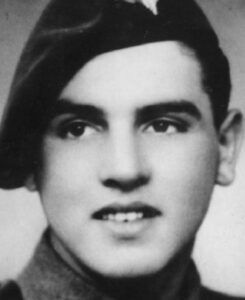
Private, British Army
Ron Tucker lied about his age to sign up for the British army in 1942 – at 16 years old he joined the Gordon Highlanders. He then volunteered to join the fledgling Parachute Regiment, and aged just 18 he dropped in Normandy in the early hours of 6th June.
Private Tucker of ‘C’ Company, 9th Parachute Battalion was one of those who dropped into Normandy with the objective of silencing the guns of the Merville Battery on the eastern flank of the invasion front – close to Sword Beach. Like many of his comrades, he was unable to take part in the assault and instead headed for his unit’s secondary objective.
Tucker described one experience during the fighting in Normandy: “I thought Id try and make some tea, so I poured some tea and water in the mess tin…I sat with my back to the wall, facing the doorway. A shell came through the room, through the wall, made a lovely clean hole and it sort of sucked me with it through the door and threw me in the yard. It didn’t explode. And when I went back there was no sign of my mess tin. I’ve no idea what happened to it. I lost my enthusiasm for making tea after that.”
Following his time in Normandy, Ron Tucker fought at the Battle of the Bulge, once describing how his blanket snapped in two when he tried to fold it. He later dropped into Germany as part of the Allied operation to cross the Rhine. As he descended under his canopy, he was raked by machine gun fire. One bullet penetrated his webbing, just missing two grenades, and impacted into a crucifix he was carrying in his pocket – almost certainly saving his life.
After the war he wrote a book alongside his childhood sweetheart and then wife, Dorothy. Entitled “A Teenager’s War” it chronicled his formative years spent on the battlefield. He and Dorothy met when they were 15 years old, and married in 1946. Their relationship lasted 66 years until Dorothy passed away in 2012.
Ron Tucker died in April 2018. In a display of comradeship and respect, members of the Parachute Regimental Association came from across the north of England to attend his funeral. His daughter, Ann Sutton, quoted Ron as saying: “Last of the rear party, joining the main Battalion, at last with all my Brothers”.
Wilson, Anna “Tony”
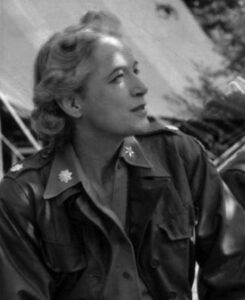
Lt. Colonel, US Army
Captain Anna “Tony” Walker Wilson arrived in England in April 1943. She was the Women’s Army Corps (WAC) Staff Directory in the European Theatre of Operations. She was the first WAC to arrive in the ETO and it was her job to make preparations for the thousands that would follow. She travelled to France after the landings in Normandy as a Lieutenant Colonel and had under her command some 6,500 women solders of the WAC.
She married in 1946 and spent time living in Berlin and Washington D.C. before retiring to California where she died in 1999 at the age of 89. During the course of service, she was awarded the Legion of Merit, the French Croix de Guerre and Legion d’honnéur, and the Order of the British Empire.
Wittmann, Michael
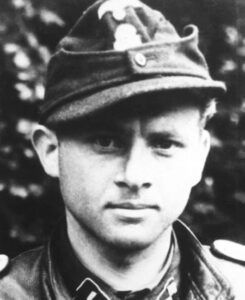
SS-Hauptsturmführer, German Army
Known in military circles as the “Black Baron”, Michael Wittmann was a Waffen-SS tank commander who was born in Bavaria in 1914. He fought in Poland and in the Battle of France, then in Greece before his unit was withdrawn to Czechoslovakia to refit.
Wittmann then fought on the Eastern Front and during the Battle of Kursk he commanded a Tiger tank which was responsible for destroying or disabling 88 Soviet tanks and anti-tank guns. In January 1944, he received the Knight’s Cross for his outstanding service to the Fatherland.
In June 1944, Wittmann was a SS-Obersturmführer (first lieutenant) in command of a company of tank in the SS Heavy Panzer Battalion 101. Following the Allied assault on D-Day, Wittmann’s battalion, which was assigned to the I SS Panzer Corps, received orders to make the 103 mile journey from Beauvais to Normandy – which took five days.
On 12th June Wittmann’s company arrived in the area of Villers-Bocage. After suffering heavy fire from Allied naval bombardment, he relocated his company three times during the night fearing they had been spotted. The following day, he emerged from cover and engaged and destroyed several British tanks and transport vehicles parked along the roadside. Moving into Villers-Bocage itself his unit engaged more tanks, scout cars and a halftrack. Wittmann’s own tank was eventually disabled by an anti-tank gun.
Whittmann was killed in August 1944 during Operation Totalize, whilst participating in at attack against British and Canadian soldiers near Saint-Aignen-de-Cramesnil. His Tiger was hit by anti-tank shells and the turret was blown off after the ammunition ignited.
He and his crew were buried in unmarked graves, but in 1983 the graves were rediscovered and the bodies of Whittmann and his crew were reinterred at La Cambe cemetery.
Yang, Kyoungjong
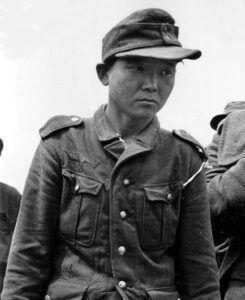
German Army
Born in 1920, Yang Kyoungjong was a Korean living in Manchuria in 1938 when the ruling Japanese conscripted him into the Kwantung Army of the Imperial Japanese Army to fight against the Soviet Union. In September 1939 during the Battles of Khalkhin Gol in Mongolia, Yang was captured by the Red Army and sent to a labour camp.
Several years later, faced with a shortage of able bodies, the Soviet Union pressed Yang and many others into fighting for them against the Germans. Whilst in the Ukraine Yang was captured by the Wehrmacht during the Third Battle of Kharkov in 1943. He was then pressed into service fighting for the Germans along with other Russian prisoners – in what was known as an “Eastern Battalion”.
Yang’s battalion was sent to the Western Front to help bolster the defenses in Normandy, and it was whilst serving there, near to Utah Beach, that he was again captured – this time by US Army paratroopers. They believed him to be a Japanese solider fighting for the Germans and he spent the rest of the war in POW camps in England and then America.
After the war, Yang settled in the Unites States and lived in Illinois until his death in 1992. In 2011 a Korean film entitled “My Way” was released, inspired by the life of Yang Kyoungjong.

